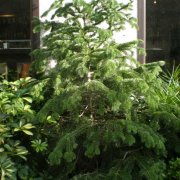Care of the tree Picea abies or European spruce |
|
The genus Picea, family Pinaceae, comprises 35 species of trees native to temperate and cold regions of Asia, Europe and North America. Some species are: Picea abies, Picea pungens, Picea mariana, Picea orientalis, Picea rubens, Picea koyamae. Common names: European spruce, Norway spruce. This species is native to Europe. They are large, slow-growing trees (conifers) that reach 60 meters (196.8 feet) in height. The evergreen leaves are thread-shaped and glossy dark green. The shoots that are born in spring are yellowish green. The fruits are hanging oval cones measuring 16 cm (6.29") in length; first they are green and then brown. European spruce is used as isolated specimens, to form screens and in small groups. In northern European countries it's used as a Christmas tree. The wood is used to make paper pulp for newspapers and building materials. Picea abies can grow in full sun or semi-shade exposures. It resists frost well. Norway spruce needs deep, moist soils; it does not withstand drought. Water regularly so that the substrate is always slightly damp but never flood. European spruce does not need pruning or fertilizers. Picea abies is a resistant plant to the usual pests and diseases. Norway spruce is propagated by seeds or by cuttings. |
Images of the tree Picea abies or European spruce |
Find plants
Picea abies or European spruce | Care and Growing
© 2025 FavThemes

